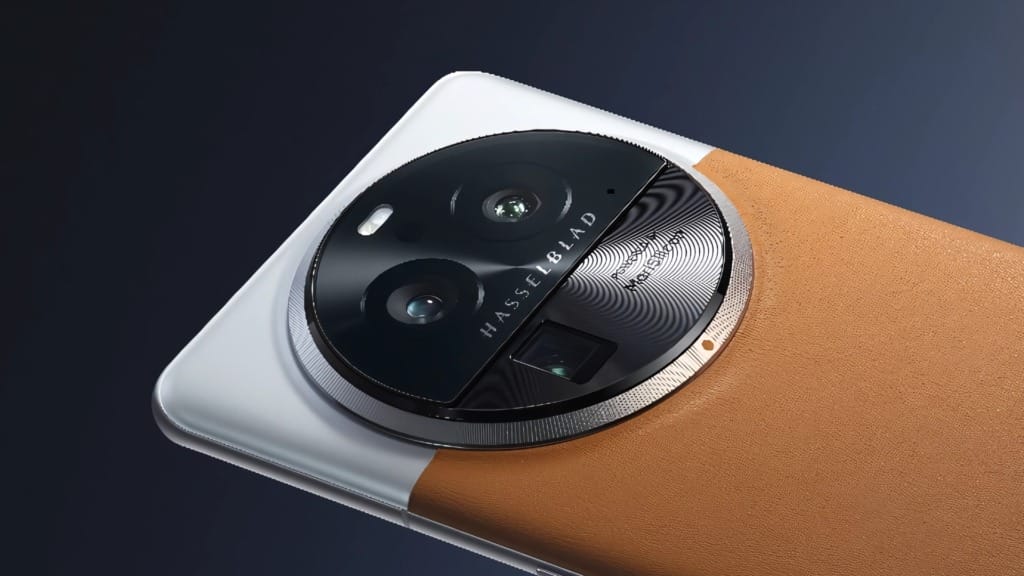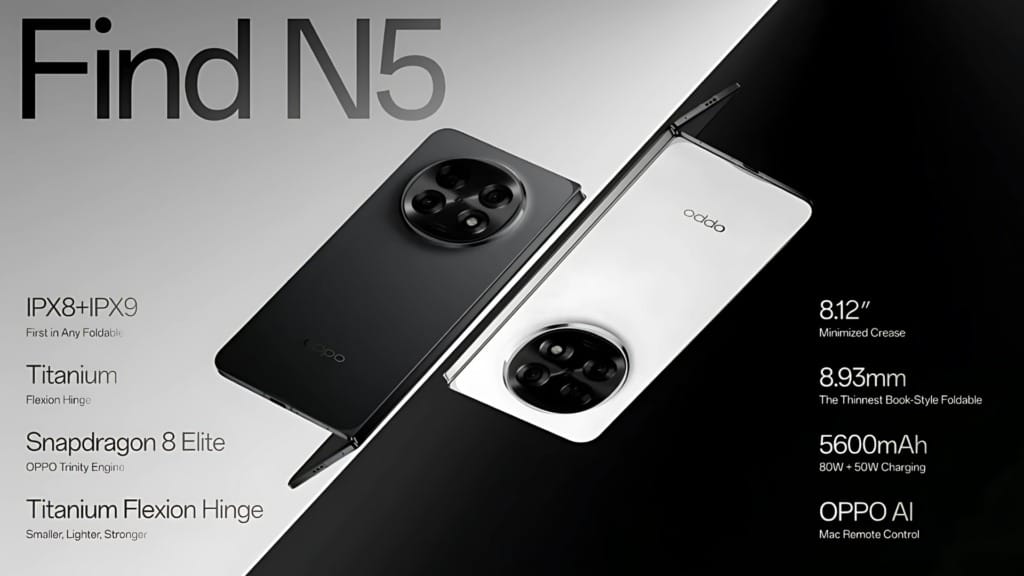When Hasselblad cameras captured the first moon landing in 1969, they cemented their place in history as pioneers of high-precision imaging. Decades later, the same brand is pushing boundaries once again—this time, in mobile photography. OPPO’s collaboration with Hasselblad for the Find N5 marks a new chapter in smartphone imaging, where computational photography and legacy optics merge to create an unprecedented mobile photography experience. But can this partnership truly redefine what’s possible in smartphone cameras, or is it just another branding exercise?

The OPPO Find N5, touted as the world’s thinnest book-style foldable phone, is more than just an engineering marvel in design. At its core lies the next generation of OPPO’s HyperTone Camera System, co-developed with Hasselblad to bring professional-grade imaging to smartphones. The system replicates Hasselblad’s classic aesthetic and integrates it into a computational framework designed for modern mobile users. With the rise of AI-driven photography and advanced sensor technology, this collaboration has the potential to bridge the gap between mobile and professional photography like never before.
But OPPO’s journey with Hasselblad didn’t begin with the Find N5. The partnership has evolved through multiple flagship models, starting with the Find X5 series in 2022. Since then, OPPO has continuously integrated Hasselblad’s imaging expertise into its premium devices, including the Find X6, Find X7 Ultra, and even the foldable Find N3 series. With each iteration, OPPO has refined its mobile imaging system, moving beyond traditional smartphone photography to create an ecosystem where foldable and slab-style phones deliver professional-grade results.
From the moon to the palm of your hand, Hasselblad’s journey has always been about capturing reality with stunning clarity. OPPO’s Find N5 continues this tradition by offering features beyond typical smartphone photography. But what makes this device stand out isn’t just the hardware—it’s the way OPPO and Hasselblad are rethinking the fundamentals of mobile imaging.
A heritage of excellence: How Hasselblad changed photography forever
Hasselblad’s reputation for precision optics and unparalleled image quality is well-earned. The Swedish company became a household name in professional photography, trusted by NASA for capturing the moon landing and countless high-profile projects since. Hasselblad has always prioritised aesthetic integrity over technical gimmicks unlike conventional camera manufacturers. Their approach to photography is deeply rooted in colour science, tonal accuracy, and the ability to capture an image exactly as the eye perceives it. This is why their cameras remain a gold standard for professional photographers across industries.
What made Hasselblad cameras legendary was their ability to shoot in extreme conditions and the level of detail and realism they delivered. Their medium-format cameras, with their larger sensors and sophisticated optics, allowed for unprecedented clarity and depth. This was evident in the iconic images taken during the Apollo missions, where the balance of light and shadow showcased the moon’s surface in breathtaking detail. Even today, photographers revere Hasselblad for its commitment to maintaining true-to-life colours, organic contrast, and exquisite depth-of-field rendering.
OPPO sought to integrate this same philosophy into its smartphones, leading to the partnership that brought the Find N5’s imaging system to life. The journey began with the Find X5 series, which first introduced Hasselblad’s influence on OPPO’s camera colour science.

This was followed by the Find X6 Pro, which featured a “Three Main Cameras” setup powered by Hasselblad’s tuning. More recently, the Find X7 Ultra took mobile imaging to another level with dual periscope telephoto lenses, providing a focal length range from 14mm to 270mm. With each iteration, OPPO has refined Hasselblad’s imaging aesthetic, ensuring that mobile photography doesn’t just mimic professional cameras but genuinely embraces their core principles.
The evolution of smartphone photography
For years, smartphone photography was driven by a race for higher megapixels and gimmicky AI filters rather than genuine image quality. While flagship phones improved their cameras over time, they still lacked the dynamic range, natural bokeh, and subtle colour gradations found in professional cameras. The integration of Hasselblad’s expertise into OPPO’s HyperTone Camera System aims to change that by shifting the focus from hardware specs to computational aesthetics. Instead of over-processing images with artificial sharpness, the Find N5 takes a more organic approach, balancing digital enhancements with optical precision.
One of the most significant breakthroughs in this partnership is OPPO’s HyperTone Image Engine, which reduces digital artefacts while improving clarity and depth. Traditionally, computational photography has struggled with issues like over-sharpening, artificial-looking blur, and colour inaccuracies. However, the Find N5’s imaging system uses AI RAW fusion to process images in a way that retains natural details while enhancing sharpness in a more subtle, human-eye-friendly manner. This allows photographers to capture scenes that look true to life rather than overly digitised.
Beyond the Find N5, OPPO’s foldable Find N3 brought flagship-level imaging to foldable devices for the first time. This device introduced Hasselblad’s Portrait Mode, an innovation that mimics the natural depth of field found in professional cameras. Unlike standard smartphone portrait modes that artificially blur backgrounds, OPPO and Hasselblad refined the algorithm to create a realistic falloff, making portrait photography look more cinematic. This same philosophy continued with the Find X8 Pro, which featured an all-50MP quad-camera system designed to deliver pro-grade mobile photography.
For professional photographers, the ability to shoot in RAW and control ISO, shutter speed, and white balance directly from the phone offers a level of manual control that was previously unheard of in mobile photography. With a foldable display that doubles as a mini-tripod, the Find N5 also makes long-exposure and self-portrait photography more accessible than ever. These innovations signal a shift in how we perceive smartphone photography—not just as a convenient alternative to dedicated cameras but as a legitimate creative tool.
Where OPPO and Hasselblad are heading
The collaboration between OPPO and Hasselblad redefines mobile photography and what’s possible. The Find N5 is just the beginning of a deeper integration between classic photographic aesthetics and computational advancements. OPPO aims to extend its HyperTone Camera System across multiple product lines, making professional-level imaging more accessible to a broader audience. The partnership’s long-term goal is to create an ecosystem where smartphones become the go-to device for high-quality creative work, not just snapshots.
One of the most exciting prospects is computational photography, where AI-driven algorithms will continue to refine image quality in ways that hardware alone cannot achieve. OPPO’s investment in its Photography Aesthetics Feature Quantification Lab shows its commitment to using machine learning to enhance photographic outcomes. With Hasselblad’s input, future OPPO devices could leverage AI to offer even more naturalistic rendering of highlights, shadows, and mid-tones, pushing smartphone cameras into an era where they can rival professional DSLRs in everyday use.

Ultimately, the Find N5 represents the future of mobile imaging. By leveraging Hasselblad’s expertise and OPPO’s computational advancements, this device is not just competing with other flagship smartphones; it’s setting new standards for the industry. As mobile photography continues to evolve, the collaboration between OPPO and Hasselblad could be the catalyst that finally makes smartphones the preferred tool for professional creatives.





